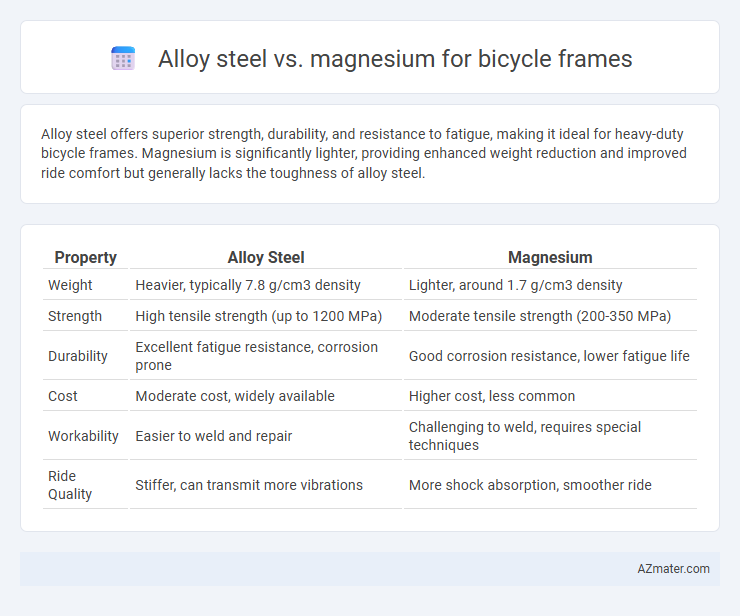Alloy steel offers superior strength, durability, and resistance to fatigue, making it ideal for heavy-duty bicycle frames. Magnesium is significantly lighter, providing enhanced weight reduction and improved ride comfort but generally lacks the toughness of alloy steel.
Table of Comparison
| Property | Alloy Steel | Magnesium |
|---|---|---|
| Weight | Heavier, typically 7.8 g/cm3 density | Lighter, around 1.7 g/cm3 density |
| Strength | High tensile strength (up to 1200 MPa) | Moderate tensile strength (200-350 MPa) |
| Durability | Excellent fatigue resistance, corrosion prone | Good corrosion resistance, lower fatigue life |
| Cost | Moderate cost, widely available | Higher cost, less common |
| Workability | Easier to weld and repair | Challenging to weld, requires special techniques |
| Ride Quality | Stiffer, can transmit more vibrations | More shock absorption, smoother ride |
Introduction: Alloy Steel vs Magnesium for Bicycle Frames
Alloy steel offers high strength, durability, and excellent fatigue resistance, making it a reliable choice for bicycle frames designed for longevity and heavy use. Magnesium, significantly lighter than alloy steel, provides superior weight savings and vibration damping, enhancing ride comfort and acceleration. Both materials present distinct advantages in frame stiffness, corrosion resistance, and manufacturing costs, impacting performance and price points for cyclists.
Material Composition and Properties
Alloy steel bicycle frames feature a combination of iron with elements such as chromium, nickel, and molybdenum, providing enhanced strength, durability, and resistance to wear and corrosion. Magnesium frames are composed primarily of magnesium with minor aluminum and zinc additions, resulting in a lightweight structure with excellent vibration damping but lower tensile strength compared to alloy steel. The higher density of alloy steel contributes to increased robustness, while magnesium's low density significantly reduces frame weight for improved ride agility.
Weight Comparison: Alloy Steel and Magnesium
Alloy steel bicycle frames typically weigh between 2.5 to 3.5 kilograms, offering high strength but increased mass compared to magnesium frames, which generally weigh around 1.5 to 2.5 kilograms. Magnesium frames provide significant weight savings due to their lower density (approximately 1.74 g/cm3) compared to alloy steel (around 7.8 g/cm3), enabling enhanced bike agility and ease of handling. Despite magnesium's lighter weight, alloy steel remains popular for its durability and fatigue resistance in high-stress cycling applications.
Strength and Durability Factors
Alloy steel offers superior strength and exceptional durability for bicycle frames, with high tensile strength and excellent fatigue resistance that withstands heavy loads and rough terrain. Magnesium frames provide a lightweight alternative but generally have lower strength and are more prone to corrosion and fatigue over time. For riders prioritizing longevity and robust performance, alloy steel remains the optimal material due to its resilience and enhanced structural integrity.
Ride Quality and Performance
Alloy steel bicycle frames offer superior ride quality due to their excellent vibration damping and durability, providing a comfortable and stable experience on varied terrains. Magnesium frames excel in performance with their lightweight properties, enhancing acceleration and maneuverability while maintaining sufficient strength for competitive cycling. The choice between alloy steel and magnesium ultimately depends on the rider's priority between comfort and agility.
Corrosion Resistance and Maintenance
Alloy steel bicycle frames offer superior corrosion resistance due to protective coatings and stable oxide layers, reducing rust formation and extending frame longevity. Magnesium frames naturally resist corrosion with proper anodizing treatments but require more frequent maintenance to prevent surface degradation in humid environments. Regular application of protective oils or sealants is essential for magnesium to maintain structural integrity and avoid corrosion-related damage.
Cost Analysis and Affordability
Alloy steel bicycle frames typically offer lower material costs compared to magnesium, making them more affordable for mass production and budget-conscious consumers. Magnesium frames, despite higher raw material and manufacturing expenses due to specialized casting and corrosion prevention processes, provide weight savings that may justify the investment for performance-oriented riders. Cost analysis reveals that alloy steel is often preferred for economical durability, whereas magnesium appeals to premium market segments seeking lightweight advantages despite higher price points.
Environmental Impact and Sustainability
Alloy steel bicycle frames offer high durability and recyclability, making them a more sustainable choice with lower environmental impact during production compared to magnesium frames, which require energy-intensive extraction and processing. Magnesium frames are lightweight and provide excellent performance benefits but pose challenges in recycling due to corrosion issues and limited recovery infrastructure. Choosing alloy steel contributes to reduced material waste and better lifecycle sustainability in bicycle manufacturing.
Popular Applications and Market Availability
Alloy steel frames are highly popular in the bicycle industry due to their strength, durability, and cost-effectiveness, making them a common choice for touring and commuter bikes available widely in global markets. Magnesium frames, though less common, are gaining traction for high-performance and lightweight applications, primarily in niche markets and specialized road or mountain bikes. Market availability of alloy steel bikes remains extensive, while magnesium options are limited but expanding as manufacturing techniques improve and demand for lightweight materials rises.
Summary: Choosing the Right Frame Material
Alloy steel frames provide durability, strength, and excellent fatigue resistance, making them ideal for riders prioritizing longevity and toughness. Magnesium frames offer a lightweight alternative with good vibration damping, enhancing ride comfort and agility for performance-focused cyclists. Selecting between alloy steel and magnesium depends on balancing weight concerns with strength requirements and intended riding conditions.

Infographic: Alloy steel vs Magnesium for Bicycle frame
 azmater.com
azmater.com